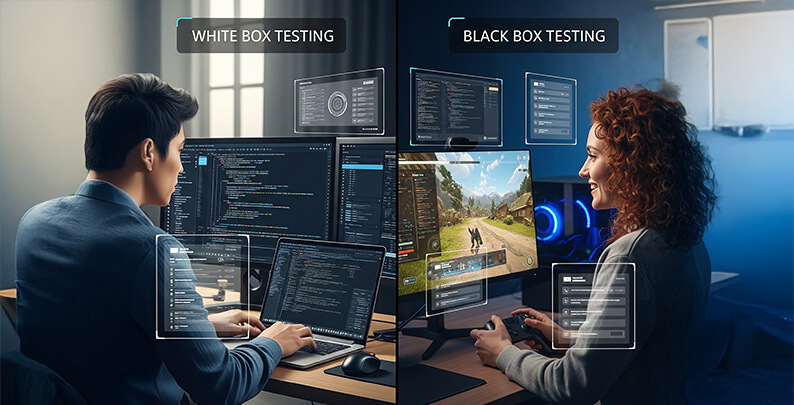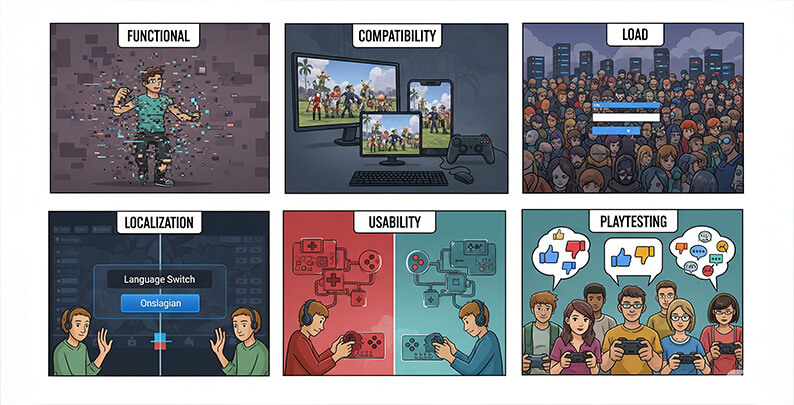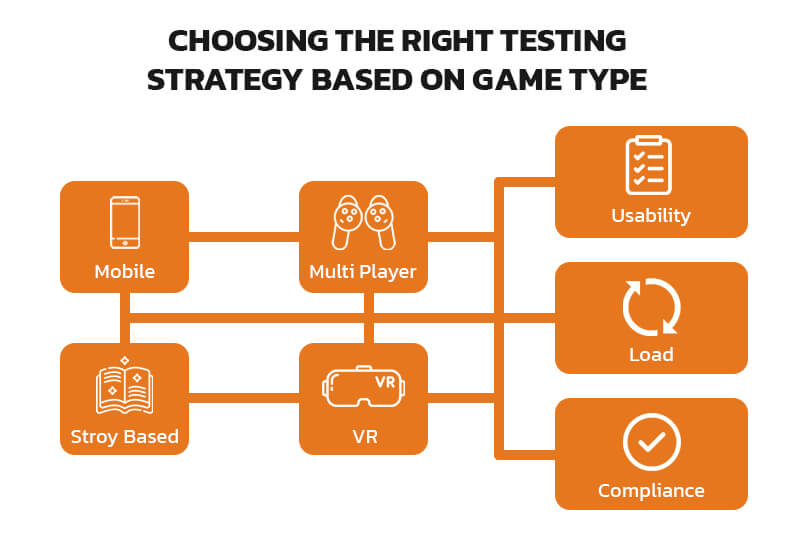Table of Contents
“Testing is an integral part of game development. It’s the process that helps transform a good game into a great one.” – Tim Sweeney (Founder of Epic Games)
Game testing is critical to game development, identifying hidden bugs and enhancing player experience. Contrary to popular belief, testing doesn’t start after production; it begins during coding and continues throughout development.
Games are generally tested for quality assurance and quality control, and their quality is measured by specific factors. Tracy Fullerton, a game designer, says, functional, internally complete, fun, balanced, and accessible are the five basic qualities needed for a good game.
Hence, console game testing, PC and mobile game testing techniques are deployed to ensure the game is good, bug-free, and offers an optimal user experience. Let us learn about game testing and the various game testing types in brief.
Game testing is a vital part of the game development process. It helps identify bugs, glitches, or technical defects that could affect the gaming experience. The process follows a user-centric approach, ensuring smooth gameplay and player satisfaction. As games grow in complexity, testing has evolved beyond traditional QA to include specialized techniques based on genre, platform, and mechanics.
Testing requirements can vary based on genre, engine, or platform. For instance, game testing platforms like consoles and PC game require different procedures due to hardware, OS, and controller variations.

There are many different types of game testing, broadly classified into two:
1. White Box Testing: Conducted by developers or QA engineers with access to internal code. This method tests logic, flow, and integration across components.
2. Black Box Testing: Testers assess game functionality without accessing the internal code. It ensures the game behaves as expected for users.
Verifies that all features and gameplay elements operate as intended. It addresses bugs such as unresponsive buttons, misfires, or crashes, ensuring smooth and predictable game flow.For instance, if a button doesn’t respond or the game crashes, it’s flagged during game functional testing.
Tests input combinations to verify whether multiple game components interact without conflicts. Pairwise testing checks component interactions with minimal test cases.
Compatibility testing is done to check if the game is compatible with various software and hardware devices. People play games on different devices and each device has different configurations and features. So, it is necessary to check if the game is compatible with multiple devices.
Additionally, game accessories like controllers, bluetooth headsets, etc., are connected to the game. It should be compatible with the game for it to work. Video cards, controllers, OS, and standards like USB should be checked for compatibility.
Assesses whether a game meets platform-specific guidelines from manufacturers like Sony, Microsoft, or Nintendo. Failure can result in launch delays or rejection from digital storefronts.
Ad hoc testing is done to check if there are any unexpected errors. It neither follows a checklist nor any test plan. The error-guessing technique is used to detect any bugs or errors in the game. This testing doesn’t follow any process, planning, or documentation. It is done randomly at any part of the game to test for any issues. Ad hoc testing helps to detect major bugs which are not able to be found in the prior testing.
When the game is tested, sometimes unexpected errors will keep on occurring, even if you fix them. In those cases, clean room testing comes in handy.
This testing helps to understand the exact reason for the bug to arise or identify the location of the bugs. Thus, helping to fix the bug permanently. It is one of the essential game testing types, to prevent the same bugs from appearing time and again.
Simulates high traffic by having multiple users interact with the game simultaneously. It checks for crashes or performance drops under pressure.
Each player is different and they have their own way of playing. Soar testing is to make sure that the game is playable under any circumstance. In this game testing, the game is left on or paused for two or three days to check the functioning of the game.
The tester plays the game leisurely and pauses the game for hours and resumes the game to check if the game functions properly. It is much like when the player leaves for a short break (for say lunch) and resumes the game again to play.
Evaluates fun and engagement. Testers play through levels and report where the game feels boring or repetitive, providing feedback to improve entertainment value.

Performed after updates or patches to ensure that new changes haven’t reintroduced old bugs. It’s crucial for live updates and ongoing support.
Video games are released worldwide. And the game developers need to make sure that it appeals to the audience worldwide and ensures a better user experience. Localization is the process where the game is released in other regions and it is optimized to the likes of the local user.
Localization testing mostly involves translation. We can see many popular games made in Japan and Korea are released in English. The games before release should undergo localization testing to make sure the translation is proper and understandable.
Some games like Zero Wing, Ghostbusters, and Sword Art Online: Hollow Fragment, were trolled mercilessly for their poor English translation.
Focuses on user-friendliness, how easily players can learn and navigate controls. It’s especially important for studios or a game design company targeting casual gamers. If you are playing the game, the main concern should be about beating the opponent and not about figuring out a way to use the control. In short, usability tests focus on providing a better user experience to the players.

Not every game needs every testing method. The ideal game testing strategy depends on several factors:
| Project Type | Recommended Testing Focus |
| Mobile Games (Casual/Hyper-Casual) | Compatibility, Usability, Load, Functional |
| Multiplayer Online Games | Load, Soak, Compliance, Regression, Open Beta |
| Story-Driven Single Player Games | Playtesting, Localization, Functional, Usability |
| Early-Stage Game Builds | Alpha, White Box, Regression |
| Games Releasing on Multiple Platforms | Compatibility, Compliance, Localization, Clean Room |
| Games with Monetization Systems | Functional, Usability, Ad Hoc (for rare or purchase bugs), Compliance |
| Games Using Controllers or VR | Usability, Compatibility, Playtesting |
When in doubt, start with functional and usability testing, then expand to more specialized testing based on your platform and user base. Tailoring QA strategies to fit your game’s genre, goals, and release roadmap, ensuring you invest in the right testing, not just all testing.
The Alpha testing is done during the production process, where the game is tested to curb any possible errors or bugs at the earliest. Alpha testing is conducted during development to identify and resolve major issues early. Testers with technical expertise validate builds at every stage to ensure system integrity.
In this testing, the tester needs to have knowledge of the software and hardware, to fix the issues and make sure the same issue does not arise again. In alpha testing, most of the major bugs are fixed.
Beta testing starts right after the completion of alpha testing. By now, the whole of the production will be completed and all the major bugs will be addressed. The beta testing makes sure that all the bugs are fixed before the game is released to the world.
The beta testing is divided into two:
Closed beta testing: In closed beta testing, the game is not open to the players and is available only to the developers and game testers to test. During this process, the game is polished and any possible bugs and defects will be fixed.
Open beta testing: In open beta testing, the game will be available for players. The external testers play the game and report any issues with the game. In some open-world massive multiplayer games, it becomes impossible to detect every issue. Stress testing is done at open beta testing with many players playing simultaneously to detect any crashes, bugs, or loading issues in the game.
For comprehensive and reliable game testing services, Juego Studios is a partner you can count on. With over a decade of experience across platforms and genres, we bring a structured yet adaptive approach to testing, covering everything from game functional testing to compatibility, localization, and regression. Our team is well-versed in handling projects for mobile, console, and PC, using a mix of manual and automated methods tailored to your game’s needs. Our QA experts ensure your game meets industry standards and player expectations. With Juego Studios, quality assurance becomes seamless, scalable, and strategically aligned with your game’s success.
Game testing plays a crucial role in game development by identifying bugs and performance issues that may affect gameplay. It starts early in the development process and continues into post-production to ensure quality. Skilled testers apply multiple video game testing services and techniques to ensure smooth functionality and an enjoyable player experience.
Juego Studios is a globally recognized game development company with a skilled team of designers, developers, testers, and artists. We provide end-to-end solutions, including mobile and cross-platform development, ensuring every game we deliver meets the highest standards in design, performance, and player satisfaction.
Game testing is essential to ensure a game runs smoothly, is free of bugs, and delivers a seamless user experience. It helps identify functional, performance, and usability issues before release, ultimately improving gameplay quality and player satisfaction. Thorough testing also ensures compatibility across devices and platforms. At Juego Studios, our experienced QA team uses industry-standard testing methods to catch even the smallest glitches. From alpha to beta testing, we ensure your game is polished, stable, and engaging, ready for a flawless launch across platforms.
Understanding the cost of game testing involves several variables like game complexity, platform, testing types, and timelines. Here’s a breakdown of typical testing costs:
| Factor | Estimated Cost (USD) | Description |
| Simple Mobile Game | $3,000 – $7,000 | Basic QA including functionality and usability testing. |
| Mid-Level Mobile/Indie PC Game | $8,000 – $15,000 | Includes compatibility, regression, and bug tracking across platforms. |
| AAA Game or Complex Multiplayer | $20,000 – $100,000+ | Extensive testing: automation, load, localization, multiplayer sync, etc. |
| Ongoing LiveOps Testing | $2,000 – $10,000/month | Continuous updates, content testing, and performance validation post-launch. |
| Specialized Testing Services | $25 – $80/hour | Includes video game testing services like security, accessibility, or VR. |
These estimates can vary based on location, studio expertise, and project needs. Juego Studios provides scalable and efficient testing tailored to your game.
Game testing is not just the final step but an ongoing process throughout game development. It begins early during production and continues post-launch to ensure optimal performance, user experience, and bug-free gameplay. While final testing phases like beta and regression testing occur near completion, testing is essential at every milestone. At Juego Studios, we integrate testing from day one, using advanced video game QA techniques to validate functionality, balance, and player engagement. Our expert team ensures that your game not only meets quality standards but also delivers a seamless experience across platforms. With Juego, quality is never an afterthought, it’s built in.
The duration of testing a game varies depending on its complexity, platform, and scope. Here’s a breakdown of typical timeframes for different testing stages:
| Type of Game | Testing Duration | Notes |
| Simple Mobile Game | 1–2 weeks | Includes basic functionality and UI testing. |
| Casual 2D Game | 2–4 weeks | Functional, usability, and compatibility testing. |
| Mid-level 3D Game | 1–2 months | Involves in-depth gameplay, performance, and compliance checks. |
| AAA Console/PC Game | 3–6+ months | Requires extensive game functional testing and multiple test phases. |
| Live Service/Multiplayer Game | Ongoing (post-launch) | Continuous updates need regular regression and LiveOps testing. |
Game testing timelines depend on iterative development cycles and updates. At Juego Studios, we tailor our QA services to your game’s specific needs.
Alpha and beta testing are two vital stages in the game testing lifecycle, each serving unique purposes before a game’s official release.
Key differences between alpha and beta testing in gaming:
Both stages help ensure the game is polished and ready for market success.
Game testing is a crucial yet complex phase of development, often riddled with diverse challenges that can impact timelines, quality, and user experience. Juego Studios, with its experienced QA team and structured testing processes, helps studios navigate these challenges efficiently to ensure a bug-free, engaging product.
Key Challenges Faced During Game Testing:
Juego Studios streamlines these aspects through robust video game testing services tailored to project needs.
In 2025, the best way to test a game combines automation, real-user feedback, and advanced QA practices tailored to evolving platforms and player expectations. Testing should begin early in the development cycle and span across multiple phases, functional testing, compatibility testing, usability, and performance assessments. Incorporating AI-powered tools and cloud-based test environments enhances accuracy and efficiency. Real-time feedback from closed alpha and open beta testers helps fine-tune gameplay and stability. At Juego Studios, we blend cutting-edge video game testing services with skilled QA experts to deliver high-quality, bug-free experiences across mobile, console, and PC platforms, ensuring your game stands out in a competitive market.